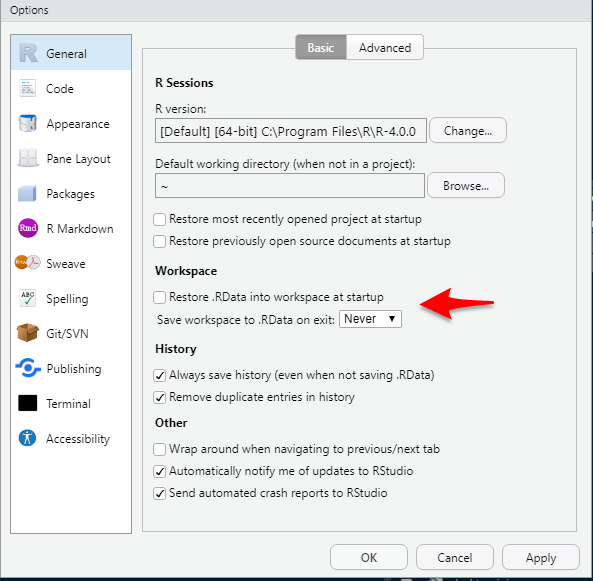
Setting Up R and RStudio
Author: Jimmy Briggs
Date: June 2, 2020
The purpose of this guide is to provide an in-depth walkthrough of the various tasks, installations, and processes involved with setting up your machine for using R.
Installing R & RStudio
The first step is to install R and RStudio from their respective websites listed below.
Download R
Install R from the main CRAN (Comprehensive R Archive Network) website: https://cran.r-project.org/.
On the page, select “Download R for Windows” > “Base” > “Download R 4.0.0 for Windows”
Note as of today the latest R version is 4.0.0
During installation, ensure that you are installing the 64-bit architecture version of R for increased RAM.
Additional Notes on R
CRAN is composed of a set of mirror servers distributed around the world and is used to distribute R and R packages.
Don’t try and pick a mirror that’s close to you: instead use the cloud mirror, https://cloud.r-project.org, which automatically figures it out for you.
A new major version of R comes out once a year, and there are 2-3 minor releases each year. It’s a good idea to update regularly.
Upgrading can be a bit of a hassle, especially for major versions, which require you to re-install all your packages, but putting it off only makes it worse.
For more details see the section discussing how to efficiently migrate R packages between versions in this guide.
- To ease the process up updating your R version it is helpful to use the
installrpackge viainstallr::updateR()(run this from the native R console not RStudio).
Download RStudio
Install the free Version of RStudio Desktop for Windows from the RStudio Website here: https://rstudio.com/products/rstudio/download/.
Additional Notes on RStudio
RStudio is an integrated development environment, or IDE, for R programming.
RStudio is updated a couple of times a year. When a new version is available, RStudio will let you know.
It’s a good idea to upgrade regularly so you can take advantage of the latest and greatest features.
Configure RStudio Settings
A range of Project Options and Global Options are available in RStudio from the Tools menu (accessible from the keyboard via Alt+T).
Most of these are self-explanatory but it is worth mentioning a few that can boost your programming efficiency:
- I highly recommend unticking the default “Restore .RData” settings box:

Unticking this default prevents loading previously created R objects. This will make starting R quicker and reduce the chance of getting bugs due to previously created objects. For this reason, I recommend you untick this box.
Alternatively you can simply run this code:
require(usethis) usethis::use_blank_slate(scope = "user")
See code{?usethis::use_blank_slate for more information.
GIT/SVN project settings allow RStudio to provide a graphical interface to your version control system.
R version settings allow RStudio to ‘point’ to different R versions/interpreters, which may be faster for some projects.
Code editing options can make RStudio adapt to your coding style, for example, by preventing the autocompletion of braces, which some experienced programmers may find annoying. Enabling Vim mode makes RStudio act as a (partial) Vim emulator.
Diagnostic settings can make RStudio more efficient by adding additional diagnostics or by removing diagnostics if they are slowing down your work. This may be an issue for people using RStudio to analyze large datasets on older low-spec computers.
Appearance: if you are struggling to see the source code, changing the default font size may make you a more efficient programmer by reducing the time overheads associated with squinting at the screen. Other options in this area relate more to aesthetics. Settings such as font type and background color are also important because feeling comfortable in your programming environment can boost productivity. Go to Tools > Global Options to modify these.
Upgrading R
Sometimes people run into difficulties whenever R updates its latest version. One should be cautious whenever the Major patch version of R is upgraded (i.e. from R3.6.1 to R4.0.0).
For minor patch updates (i.e. R3.6.3 to R3.7.0 or R3.6.4), it is usually a good idea to update your local version as these updates incorporate bugfixes and speed enhancements.
On major updates, it is best practice to keep your old version of R on your machine until you are comfortable with the updated R version.
A very useful feature of RStudio is that you can have multiple versions of R installed on your computer at the same time and by holding down the Control key during the launch of RStudio you can cause the R version selection dialog to display at startup.
When migrating R versions between major patch updates, you will need to re-install you library of R packages. This process can be vastly expedited utilizing installr’s helpful installr::copy.packages.between.libraries() function.
Installing and Setting Up Additional Software and Utilities
To get the most out of R and RStudio it is helpful to install these additional software resources:
RTools
Git
A Git Client GUI (or just use RStudio)
Git LFS
Mercurial
-
Tex Distribution
- Tinytex
- Miketex
- TexLive
Java
Pandoc
Node.js
Hugo
Inno
Here’s the code to install these additional resources:
if (!require(pacman)) install.packages("pacman") pacman::p_load(devtools, installr, tinytex, rstudioapi, magrittr, dplyr, pkgbuild) # configure RStudio settings ---------------------------------------------- # disable reloading of workspace between sessions usethis::use_blank_slate(scope = "user") # review system environment variables: Sys.getenv() # configure your R library path for R packages .libPaths() # copy packages to new R-version's windows library libdir_prior <- file.path("<enter prior win-library path here>") libdir_current <- file.path("<enter current win-library path here>") installr::copy.packages.between.libraries( from = libdir_prior, to = libdir_current ) # check .libPaths()[1] == libdir # configure dotfiles .Rprofile & .Renvrion -------------------------------- # review dotfiles usethis::edit_r_environ(scope = "user") # (RTools Path, github PAT, keys, etc.) usethis::edit_r_profile(scope = "user") # (various options for packages) # additional software --------------------------------------------- pkgbuild::setup_rtools() # Rtools installr::install.rtools() rstudioapi::restartSession() # git installr::install.git() rstudioapi::restartSession() # tinytex tinytex::install_tinytex() rstudioapi::restartSession() tinytex::use_tinytex() # java installr::install.java() # pandoc installr::install.pandoc() # node.js (only if desired) installr::install.nodejs() # github Git Client (only if desired) installr::install.github() # inno (only if desired) installr::install.inno()
Note that not all of these are required, however, I recommend at a minimum to install RTools, Git, Pandoc, and a Latex service.
I have provided an R script named R-Setup-Script.R with this guide that uses the installr package to help ease the process of installing all these extra resources.
Advanced Configuration
This section discusses more advanced R related configurations such as:
- Environment Paths
- Detailed System Information
- Dotfiles
- Common pitfalls
For more advanced R developers you may want to further configure your development environement by customizing you R related dotfiles; specifically, your .Rprofile and .Renviron.
Here is what my minimal setup includes:
Additionally, you can configure keybinding for RStudio addins from RStudio and store them within the .R folder located in your R_USER path. To view this path run Sys.getenv("R_USER").
On a windows computer, you may need to adjust where the system chooses to look for various R related items on your system. For example, the path to your RTools bin executable, your HOME path, your library path for packages, and many other windows specific paths. Note the difference between SYSTEM PATHS and USER PATHS.
To add your system RTOOLS PATH to your .Renviron (easier than manually configuring within windows system settings) run the code:
cat('PATH = ${RTOOLS40_HOME}\\usr\\bin;${PATH}', file = fs::path(Sys.getenv("R_USER"), "/.Renviron"), append = TRUE)
Memory in R
R breaks down memory usage into Vcells (memory used by vectors) and Ncells (memory used by everything else).
However, neither this distinction nor the “gc trigger” and “max used” columns are typically important. What we’re usually most interested in is the the first column: the total memory used.
A helpful function one can use for this is pryr::mem_used which wraps around gc() to return the total amount of memory (in megabytes) currently used by R. pryr::object_size() is another helpful function which works similarly to utils::object.size() but counts more accurately and includes the size of environments. pryr::compare_size makes it easy to compare the output of object_size and object.size.